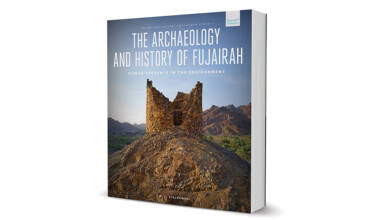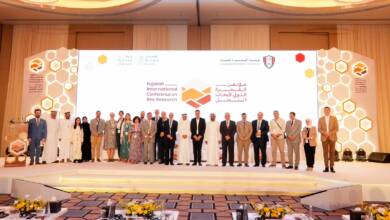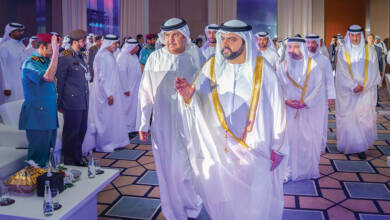The Islamic arts also bear the imprint of the Qur’an in terms of its meanings (ma¢ānī) and structures (mabānī).
Like many sacred texts, many of the surahs and verses of the Qur’an have a chiastic, or ring, structure. That is, the final section mirrors the first, the penultimate section mirrors the second, and so on, until the center, which contains the main theme or message.
This symmetric, polycentric structure of overlapping patterns is clearly reflected in the geometric patterns of illumination that adorn Qur’anic manuscripts; the tessellations that adorn the mosques, madrasas, and homes where its verses are chanted; and even the structure of the musical maqāms in which it is recited.
Islamic art is founded on the interconnected sacred sciences of mathematics, geometry, music, and cosmology, not so different from the medieval Christian notion of ars since scientia nihil est (art without science is nothing).
All of these sciences connect the multiplicity of creation to the unity of the Creator and engage the qualitative, symbolic aspects of multiplicity as well as its quantitative dimensions.
Aristotle divided philosophy into three parts: physics, mathematics, and theology (ilāhiyyāt). Physics addresses the natural or material world, and theology the divine, while mathematics (and the associated sciences of geometry and music, which are numbers in space and time, in the visual and sonoral domains, respectively) deals with the intermediate, archetypal, imaginal realm—the barzakh, between the divine and the terrestrial.
These sciences of the intermediate realm allow the Islamic arts to serve as a ladder from the terrestrial to the celestial, from the sensory to the spiritual. They also have their foundation in Islamic metaphysics and spirituality, which give the artists direct access to the spiritual realities and truths represented in their art.
The Two Streams of Islamic Art
Beauty is found in two things: in a verse, and in a tent of skin.
– Emir ¢Abd al-Qādir al-Jazā’irī
While the Islamic arts are many and diverse, they can be roughly categorized into two domains: adab and ambience—that is, the arts of language and those that create the environment in which people live (such as dress, architecture, urban design, and perfume).
In precolonial times, both of these domains were nearly ubiquitous; they were part of the education of not only Islamic scholars but all Muslims. Virtually all scholars studied, quoted, and wrote poetry.
Some of the finest masterpieces of Islamic architecture are madrasas, such as the Bou Inania of Fes and Ulugh Beg in Samarqand, because it was understood that architecture can support and nourish the soul, kindle the intellect, and nurture all the other Islamic sciences.
Moreover, the arts of adab and ambience were not limited to mosques, madrasas, and palaces but determined the structure and form of the cities and homes in which Muslims lived, not to mention the utensils and tools they used; the clothes they wore; and the melodies, poetry, and idioms that filled their hearts and flowed from their tongues.
As Ananda Coomaraswamy notes, in traditional societies, “the artist was not a special kind of man, but every man a special kind of artist.”
“Adab” is a word that is notoriously difficult to translate into English. Meaning at once “custom, culture, etiquette, morals, courtesy, decorum, and civilized comportment, as well as literature,” to have adab is to be well-read and educated, to have good manners, to be cultured or refined, and to have the wisdom to give everything and everyone their due rights.
The literature of adab is so named because it is designed to cultivate adab in its readers. Studying Islamic literature in the traditional fashion shapes and refines one’s soul, intelligence, behavior, and speech according to the prophetic norm of elegance and eloquence.
The most ubiquitous and important art that creates an Islamic ambience is the recitation of the Qur’an. This is the first and highest form of Islamic art, from which all others are derived.
The precise art of tajwīd and the science of the maqāms, the musical modes in which the Qur’an is recited, bring out the beauty and geometry of the Qur’anic revelation as it was revealed to the Prophet ﷺ.
In reciting the Qur’an, we participate in the divine act of revelation and the prophetic act of reception, both of which have a profoundly transformative effect on our souls. The sound of Qur’anic recitation is an integral part of the soundscape of any Islamic city or town and is nearly always arrestingly beautiful.
This is significant because in traditional Islamic civilization, truth (of which the Qur’an is the highest example) is always accompanied by beauty. In fact, beauty is a criterion of the authentically Islamic. There is nothing Islamic that is not beautiful.
This axiom governs every other traditional art of ambience, such as calligraphy; architecture and geometric design; music; and even dress, food, and perfume. It is important to examine music as an Islamic art more closely.
All of the Islamic arts exist to support the supreme art: the purification of the soul, the cultivation of character, and the remembrance of God.
“I was sent only to perfect the beauty of character,” the Prophet ﷺ said. There is no question of “art for art’s sake” in the Islamic arts because all of them have practical, psychological, and spiritual functions.
The Islamic arts are not a luxury; rather, they serve as essential supports for that art which is the raison d’être of Islamic law, theology, and indeed the entire Islamic tradition—the realization of the full potential of the human state (and thus the entire cosmos, through humanity’s role as khalīfah) through the remembrance of God.
The neglect of the Islamic arts has severely crippled the ummah’s ability to pursue this highest art, both individually and collectively.




